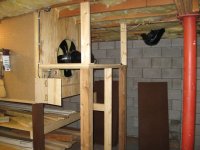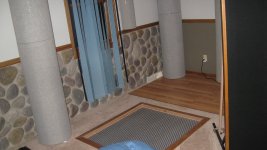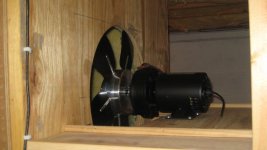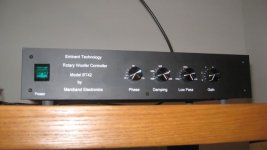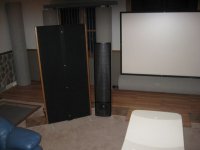Dear all,
I am a newbie to this forum. I am an organist and has a virtual pipe organ set up at home . now I want to build a infrasonic subwoofer to reproduce the pedal sounds . the range of sound is around 10-20Hz.
can any one suggest a good woofer specification and enclosure design to for reaching these low frequencies .And also the amp. for powering this subwoofer.
thanks in advance,
Alex.
I am a newbie to this forum. I am an organist and has a virtual pipe organ set up at home . now I want to build a infrasonic subwoofer to reproduce the pedal sounds . the range of sound is around 10-20Hz.
can any one suggest a good woofer specification and enclosure design to for reaching these low frequencies .And also the amp. for powering this subwoofer.
thanks in advance,
Alex.
You should specify how loud you want it and at what frequency because that is where the $ comes in. Or goes out. Also the size of the room, as most rooms are not big enough, one needs a quite big room to support 16Hz as the wave is 62FT long? Not to mention fit the speakers in it.
a simple answer might be 1-2KW of amplifier, special ones that can go that low. at least four 18" or maybe 30" speakers. It won't perform right unless it is all designed to work together.
Really a question for an expert.
a simple answer might be 1-2KW of amplifier, special ones that can go that low. at least four 18" or maybe 30" speakers. It won't perform right unless it is all designed to work together.
Really a question for an expert.
There's your expert. unfortunately no link to the work because I'd sure like to see that too.
It's here. http://www.diyaudio.com/forums/subwoofers/233612-infrabass-speaker.html
It's here. http://www.diyaudio.com/forums/subwoofers/233612-infrabass-speaker.html
Last edited:
Another possible way to go http://www.diyaudio.com/forums/subw...iman-velocity-coupled-infra-bass-speaker.html
There are some plans on the www.
http://www.diyaudio.com/forums/subw...iman-velocity-coupled-infra-bass-speaker.html
There are some plans on the www.
http://www.diyaudio.com/forums/subw...iman-velocity-coupled-infra-bass-speaker.html
You should specify how loud you want it and at what frequency because that is where the $ comes in. Or goes out.
This is true. You need to state your goals before anyone can help.
Also the size of the room, as most rooms are not big enough, one needs a quite big room to support 16Hz as the wave is 62FT long? Not to mention fit the speakers in it.
This is not true. If it was headphones wouldn't work. You don't have to fit a whole wavelength into a room to hear it.
Another possible way to go http://www.diyaudio.com/forums/subw...iman-velocity-coupled-infra-bass-speaker.html
There are some plans on the www.
http://www.diyaudio.com/forums/subw...iman-velocity-coupled-infra-bass-speaker.html
Despite it's name, that thing doesn't do any infra bass at all. It's been simulated, it's been measured, it's a waste of time.
AFAIK, this is the current value leader.
Stereo Integrity | HT Subwoofers
Get a bunch of those, enough amp power to push them and use a concrete room and seal it up as airtight as possible. Never mind the neighbours complaints, they are just jealous. (Seriously though, the sound will travel for miles.)
Stereo Integrity | HT Subwoofers
Get a bunch of those, enough amp power to push them and use a concrete room and seal it up as airtight as possible. Never mind the neighbours complaints, they are just jealous. (Seriously though, the sound will travel for miles.)
There used to be some really nice 15 inch long throw subs available from JAYCAR in Australia. They stopped selling them and I have not seen anything quite like them in Australia since. These were cheap as well - which if you want to make LOTS of bass is important, as you need LOTS of swept volume.
They were really well suited to a 200l box tuned to 19Hz, and gave really solid responce to below 20Hz. I built a lounge suite that was actually an 800l enclosure with four of these in it. At 250W into each it is absolutely hilarious.
So what am I getting to?
- You will need a really long throw woofer (irrespective of how you load it)
- It will need a very low Fs
- You will need a massive enclosure (irrespective of loading)
Options are:
- Bass Reflex - which will be prodigious in size, and probably do BAD things below resonance. Some clever EQ / protection is well warranted.
- Sealed - which will without a shadow of a doubt need a ton of EQ.
- Infinite baffle, which is a degenerate case of sealed and will need similar EQ.
If you find drivers well suited to this at a fair price, let me know.
They were really well suited to a 200l box tuned to 19Hz, and gave really solid responce to below 20Hz. I built a lounge suite that was actually an 800l enclosure with four of these in it. At 250W into each it is absolutely hilarious.
So what am I getting to?
- You will need a really long throw woofer (irrespective of how you load it)
- It will need a very low Fs
- You will need a massive enclosure (irrespective of loading)
Options are:
- Bass Reflex - which will be prodigious in size, and probably do BAD things below resonance. Some clever EQ / protection is well warranted.
- Sealed - which will without a shadow of a doubt need a ton of EQ.
- Infinite baffle, which is a degenerate case of sealed and will need similar EQ.
If you find drivers well suited to this at a fair price, let me know.
Dear all,
I am a newbie to this forum. I am an organist and has a virtual pipe organ set up at home . now I want to build a infrasonic subwoofer to reproduce the pedal sounds . the range of sound is around 10-20Hz.
can any one suggest a good woofer specification and enclosure design to for reaching these low frequencies .And also the amp. for powering this subwoofer.
thanks in advance,
Alex.
Use a rotary subwoofer and your virtual
pipe organ will sound about as real as it
gets. I couldn't be happier with this
rotary subwoofer!!!!!
Attachments
IB sub with few 18" should do that. Two for small room and 4 or more to bigger one. Ficar IB318 is one option for driver.
How much?! (Subwoofer fan+amp) The price plays a significant role here.Use a rotary subwoofer and your virtual
pipe organ will sound about as real as it
gets. I couldn't be happier with this
rotary subwoofer!!!!!
What to expect? tittualex, besides the space for the architecture and interior decorations (extra rooms and space), you will need to make accommodation for the requirements for this type of project. Other experiments/simulations have been made. Use the rotary subwoofer if you can afford it. Total $21,950-$25,950.
Eminent Technology Model 17
Take as an example the discontinued Maelstrom 21" DVC by Exodus Audio. You will need a BR enclosure typically 450/500 L and amps enough to drive the driver to max Xmax, close to 4500/5000 W @4/5 Ohms (144.50 V) each. The amp needs to run in passive mode, no-fan/no-noise (Crown type) or with on/off mode (Yamaha type) for a quite environment (or place amps in the next adjoining room away from auditorium). You can expect from such setups (SPL@1.00m) 130dB with 2/3 drivers. You can very much play with frequencies 7-20Hz and will need a system that provides auto or adjustable room equalization. 🙂
How much?! (Subwoofer fan+amp) The price plays a significant role here.
What to expect? tittualex, besides the space for the architecture and interior decorations (extra rooms and space), you will need to make accommodation for the requirements for this type of project. Other experiments/simulations have been made. Use the rotary subwoofer if you can afford it. Total $21,950-$25,950.
Eminent Technology Model 17
Take as an example the discontinued Maelstrom 21" DVC by Exodus Audio. You will need a BR enclosure typically 450/500 L and amps enough to drive the driver to max Xmax, close to 4500/5000 W @4/5 Ohms (144.50 V) each. The amp needs to run in passive mode, no-fan/no-noise (Crown type) or with on/off mode (Yamaha type) for a quite environment (or place amps in the next adjoining room away from auditorium). You can expect from such setups (SPL@1.00m) 130dB with 2/3 drivers. You can very much play with frequencies 7-20Hz and will need a system that provides auto or adjustable room equalization. 🙂
I built the enclosure and modified the floor opening (structural)
and the total cost was $15,000 including the amp that
pitches the blades.
The cost of $21,950 to $25,950 is for the entire project,
which Bruce Thigpen would do (construction, design,
installation and testing.
One needs a very large space for the rotary to vent into,
which I used my entire basement (a small space limits the
output somewhat, not the extension of the rotary.
The amp is designed by Marchand Electronics and is rated
at 200 watts, which is more than enough to pitch the blades
of the rotary sub. The real power comes from the 20 amp
circuit that powers the fan motor. The price was $1200. for
this amp.
It is still not cheap, but it is to me the most realistic subwoofer
that can outdo any conventional subwoofer (worth every penny).
Infra bass down to below 1 hz and transient response that
is awesome!!!! More power than one would ever need and
can handle any recording with out overdriving or destroying
the rotary sub.
Attachments
Thank you all, for all your comments... I will be using the sub in a room with dimn. (18'x10'x10'). rotary sub woofer is way too costly and i cant make much alterations to my room for fixing the rotary sub.
Alex
Alex
More power than one would ever need and
can handle any recording with out overdriving or destroying
the rotary sub.
This statement is completely subjective and completely untrue. I've seen a bunch of installation pics with 2 or 3 rotary subs used in a modest living room type setup. For churches and other commercial usage I've seen many more used - the most I could find in a quick search was 6 but I've seen pics with even more used.
There's no doubt that the rotary sub is impressive but it could easily be beat by conventional drivers (in multiples) given the same budget and size limitations.
The number of subs required (rotary or conventional) has a lot to do with the room (construction, leakage and size), the desired spl and the available budget.
Here's some pics of multiple rotary subs. One domestic, one church, one commercial. (The commercial pic shows 6 subs, link to the writeup is here - Niagara Falls Fury rotary woofer installation )
An externally hosted image should be here but it was not working when we last tested it.
An externally hosted image should be here but it was not working when we last tested it.
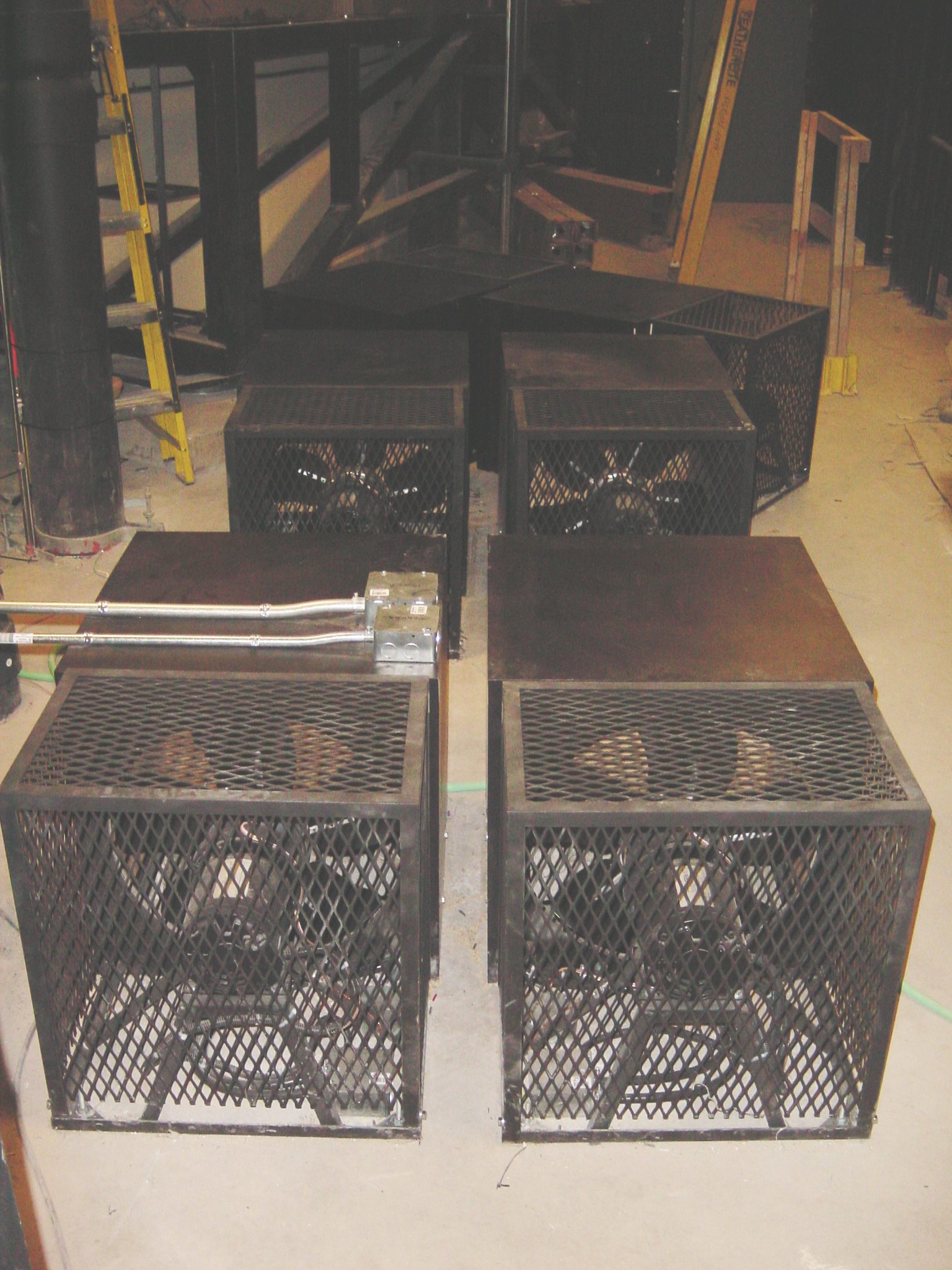
Last edited:
This statement is completely subjective and completely untrue. I've seen a bunch of installation pics with 2 or 3 rotary subs used in a modest living room type setup. For churches and other commercial usage I've seen many more used - the most I could find in a quick search was 6 but I've seen pics with even more used.
There's no doubt that the rotary sub is impressive but it could easily be beat by conventional drivers (in multiples) given the same budget and size limitations.
The number of subs required (rotary or conventional) has a lot to do with the room (construction, leakage and size), the desired spl and the available budget.
Here's some pics of multiple rotary subs. One domestic, one church, one commercial. (The commercial pic shows 6 subs, link to the writeup is here - Niagara Falls Fury rotary woofer installation )
An externally hosted image should be here but it was not working when we last tested it.
An externally hosted image should be here but it was not working when we last tested it.

Those installations, except one are commercial
installations and are huge in size requiring a lot
of subs.
Mine room is 20' wide x 30' long and I use
less than the full output of the rotary sub.
Transient response with rotary sub (below 10 hz
is one of the hardest things to get right, and the
rotary excels in this area.
I saw one installation with (eight 18" subwoofers)
with 10,000 watts of power that could equal
the rotary and surpass the output, but I am
talking about one rotary sub. No single
conventional sub can produce enough energy
below 10 hertz that can do what the rotary can
achieve, especially with only 200 watts!!
If one has the room for this many drivers,
and enough power, this would work well,
if loudness is one's only criteria.
Distortion is low with the rotary sub and
is a perfect match for my Magnepanar Tympani
IV's (coherence is superb with no apparent
colorations, which one would get with conventional
subs.
Attachments
Fwiw, if i am not mistaken, the venue had replaced all the fan subs at Niagara with a couple (2) big Tapped horns a few years ago.
Best,
Tom
Best,
Tom
Mine room is 20' wide x 30' long and I use
less than the full output of the rotary sub.
Like I said, I've seen pics of 3 rotary subs used in a home theater no larger than yours. I can't find the pics right now but they are out there somewhere. Let me repeat - the number of subs required (rotary or conventional) has a lot to do with the room (construction, leakage and size), the desired spl and the available budget.
Just because you are happy with one in your room doesn't mean much to anyone else. You haven't listed any specs, room details or anything else, all you've stated is a completely subjective judgement that doesn't mean anything to anyone except you.
I saw one installation with (eight 18" subwoofers)
with 10,000 watts of power that could equal
the rotary and surpass the output, but I am
talking about one rotary sub. No single
conventional sub can produce enough energy
below 10 hertz that can do what the rotary can
achieve, especially with only 200 watts!!
If one has the room for this many drivers,
and enough power, this would work well,
if loudness is one's only criteria.
Distortion is low with the rotary sub and
is a perfect match for my Magnepanar Tympani
IV's (coherence is superb with no apparent
colorations, which one would get with conventional
subs.
Again, let me repeat - There's no doubt that the rotary sub is impressive but it could easily be beat by conventional drivers (in multiples) given the same budget and size limitations.
I'm not sure what colorations you think conventional subs are subject to that rotary subs are immune from, but physics says they can both do the same job just fine and with low distortion. In fact, the conventional drivers won't have any fan noise to filter out (and no matter what you do you'll never completely eliminate the fan noise).
Saying that your rotary sub only uses 200 watts is not really true either. The 200 watts is only for pitching the blades, and that's not what creates the acoustic power. The fan itself creates the acoustic output and it uses a 1/3 hp motor IIRC, which runs full speed ALL THE TIME, not just when needed like conventional drivers. So if you add up all the power the rotary sub uses it will actually be more than conventional drivers would use.t
Besides, $1200 for a 200 watt amp? You can get 14000 watts rms these days for well under $1000 shipped to your door, all fees and taxes included.
Even so, it doesn't take all that much power to get a bunch of conventional drivers to hit xmax at 3 hz, I don't think you'd need anywhere near 10000 watts to beat your rotary sub with conventional drivers. I haven't run the numbers but I'm confident that I could beat your rotary sub by quite a bit (in terms of max spl, distortion and ambient noise) with conventional drivers with a fraction of budget and using no more space than you currently use. There was a time (even just a few years ago) when conventional drivers were quite expensive. But prices are falling exponentially and will continue to fall as time goes by. The rotary sub can't compete any more unless it's dramatically cheaper than it used to be.
AFAIK this is the current value leader in LF conventional drivers, and next year there will be something even cheaper.
Stereo Integrity | HT Subwoofers - 18 inch driver
Stereo Integrity | Order Online - price list
10 of those drivers and a 14000 watt amp are less than $3000 total. For the $15000 you paid you could get more than 50 of those drivers and at least 5 of the 14000 rms amps. You do the math.
Last edited:
This is true. You need to state your goals before anyone can help.
This is not true. If it was headphones wouldn't work. You don't have to fit a whole wavelength into a room to hear it.
Thank you for correcting that misconception.
Fwiw, if i am not mistaken, the venue had replaced all the fan subs at Niagara with a couple (2) big Tapped horns a few years ago.
Best,
Tom
Where was I when it was time to show up and say "here, let me haul that old junk off for you.." 😉
Many goodies have come my way by those means.
- Status
- Not open for further replies.
- Home
- Loudspeakers
- Subwoofers
- Infra sonic subwoofer design
